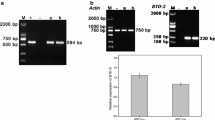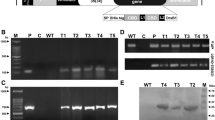Abstract
Three antimicrobial peptides exhibiting in vitro antifungal activity were expressed in Arabidopsis to compare their in planta activity. β-Purothionin, cecropin B, and phor21 were expressed under an endogenous promoter with moderate-level activity and excreted extracellularly. Expression of β-purothionin rendered the greatest antibacterial and antifungal resistance while cecropin B enhanced only antibacterial activity and phor21 did not improve antimicrobial resistance. The transgenic β-purothionin arrested fungal growth on leaf surfaces and infection of stomata. Leaf extracts from plants producing β-purothionin and cecropin B displayed membrane permeabilizing activity. The in planta antimicrobial activity of the tested peptides was consistent with previously reported in vitro experiments. The expression strategy allowed enhanced antifungal resistance without high-level transgene expression.








Similar content being viewed by others
Abbreviations
- 35S:
-
Enhanced CaVM 35S
- CA:
-
A. thaliana chloroplast carbonic anhydrase
- cfu:
-
Colony forming unit
- GFP:
-
Green fluorescent protein
- EGFP:
-
Enhanced green fluorescent protein
- GUS:
-
β-Glucuronidase
- GUSP:
-
β-Glucuronidase Plus
- MU:
-
4-Methylumbelliferon
- RSP:
-
Rice endochitinase signal peptide
References
Alan AR, Earle ED (2002) Sensitivity of bacterial and fungal plant pathogens to the Lytic Peptides, MSI-99, Magainin II, and Cecropin B. Mol Plant Microbe Interact 15:701–708
Alan AR, Blowers A, Earle ED (2004) Expression of a magainin-type antimicrobial peptide gene (MSI-99) in tomato enhances resistance to bacterial speck disease. Plant Cell Rep 22:388–396
Arguello-Astorga G, Herrera-Estrella L (1998) Evolution of light-regulated plant promoters. Annu Rev Plant Physiol Plant Mol Biol 49:525–555
Bechtold N, Pelletier G (1998) In planta Agrobacterium-mediated transformation of adult Arabidopsis thaliana plants by vacuum infiltration. Methods Mol Biol 82:259–266
Bevins CL, Zasloff M (1990) Peptides from frog skin. Annu Rev Biochem 59:395–414
Bohlmann H, Clausen S, Behnke S, Giese H, Hiller C, Reimann-Philipp U, Schrader G, Barkholt V, Apel K (1988) Leaf-specific thionins of barley—a novel class of cell wall proteins toxic to plant-pathogenic fungi and possibly involved in the defense mechanism of plants. EMBO J 7:1559–1565
Boman HG (1995) Peptide antibiotics and their role in innate immunity. Annu Rev Immunol 13:61–92
DeGray G, Rajasekaran K, Smith F, Sanford J, Daniell H (2001) Expression of an antimicrobial peptide via the chloroplast genome to control phytopathogenic bacteria and fungi. Plant Physiol 127:852–862
Epple P, Apel K, Bohlmann H (1997) Overexpression of an endogenous thionin enhances resistance of Arabidopsis against Fusarium oxysporum. Plant Cell 4:509–520
Garcia-Olmedo F, Molina A, Alamillo JM, Rodriguez-Palenzuela P (1998) Plant defense peptides. Biopolymers 47:479–491
Guilley H, Dubley RK, Jonard G, Balasz E, Richards KE (1980) Nucleotide sequence of cauliflower mosaic virus DNA. Cell 21:285–294
Hancock REW, Lehrer RI (1998) Cationic peptides: a new source of antibiotics. Trends Biotechnol 16:82–88
Haseloff J, Siemering KR, Prasher DC, Hodge S (1996) Removal of a cryptic intron and subcellular localization of green fluorescent protein are required to mark transgenic Arabidopsis plants brightly. Proc Natl Acad Sci USA 94:2122–2127
Iwai T, Kaku H, Honkura R, Nakamura S, Ochiai H, Sasaki T, Ohashi Y (2002) Enhanced resistance to seed-transmitted bacterial diseases in transgenic rice plants overproducing an oat cell-wall-bound thionin. Mol Plant Microbe Interact 15:515–521
Javadpour MM, Juban MM, Martho Lo M, Wai-Chun J, Bishop SM, Brannon J, Cowell SM, Calvin BL, McLaughlin ML (1996) De novo antimicrobial peptides with low mammalian cell toxicity. J Med Chem 3916:3107–3113
Jefferson RA (1987) Assaying chimeric genes in plants: the GUS gene fusion system. Plant Mol Biol Rep 5:387–405
Keogh RC, Deverall BJ, McLeod S (1980) Comparison of histological and physiological responses to Phakopsora pachyrhizi in resistant and susceptible soybean. Trends Br Mycol Soc 74:329–333
Matsuzaki K (1999) Why and how are peptide–lipid interactions utilized for self-defence? Magainins and tachyplesins as archetypes. Biochim Biophys Acta 1462:1–10
Meyer P (2000) Transcriptional transgene silencing and chromatin components. Plant Mol Biol 43:221–234
Mitsuhara I, Matsufuru H, Ohshima M, Kaku H, Nakajima Y, Murai N, Natori S, Ohashi Y (2002) Induced expression of sarcotoxin IA enhanced host resistance against both bacterial and fungal pathogens in transgenic tobacco. Mol Plant Microbe Interact 13:860–868
Moroney JV, Bartlett SG, Samuelsson G (2001) Carbonic anhydrases in plants and algae. Plant Cell Environ 24:141–153
Muskens MW, Vissers AP, Mol JN, Kooter JM (2000) Role of inverted DNA repeats in transcriptional and post-transcriptional gene silencing. Plant Mol Biol 43:243–260
Niidome T, Anzai S (1999) Effect of amino acid substitution in amphiphilic α-helical peptides on peptide–phospholipid membrane interaction. J Pept Sci 5:298–305
Oard S, Rush M, Oard J (2004) Characterization of antimicrobial peptides against a U.S. strain of the rice pathogen Rhizoctonia solani. J Appl Microbiol 97:169–180
Owens LD, Heutte TM (1997) A single amino acid substitution in the antimicrobial defense protein cecropin B is associated with diminished degradation by leaf intracellular fluid. Mol Plant Microbe Interact 10:525–528
Pan XB, Rush MC, Sha XY, Linscombe SD, Stetina SR, Oard J (1999) Major gene, nonallelic sheath blight resistance from the rice varieties Jasmine 85 and Teqing. Crop Sci 39:338–346
Powell WA, Catranis CM, Maynard CA (1995) Synthetic antimicrobial peptide design. Mol Plant Microbe Interact 8:792–794
Rajasekaran K, Stromberg KD, Cary JW, Cleveland TE (2001) Broadspectrum antimicrobial activity in vitro of the synthetic peptide D4E1. J Agric Food Chem 49:2799–2803
Reimann-Philipp U, Schrader G, Martinoia E, Barkholt V, Apel K (1989) Intracellular thionins of barley. J Biol Chem 264:8978–8984
Romero A, Alamillo JM, Garcia-Olmedo F (1997) Processing of thionin precursors in barley leaves by a vacuolar proteinase. Eur J Biochem 243:202–208
Roth B, Poot M, Yue S, Millard P (1997) Bacterial viability and antibiotic susceptibility testing with SYTOX Green nucleic acid stain. Appl Environ Microbiol 63:2421–2431
Shai Y (1999) Mechanism of the binding, insertion and destabilization of phospholipid bilayer membranes by α-helical antimicrobial and cell non-selective membrane-lytic peptides. Biochim Biophys Acta 1462:5570
Sharma A, Sharma R, Imamura M, Yamakawa M, Machii H (2000) Transgenic expression of cecropin B, an antibacterial peptide from Bombyx mori, confers enhanced resistance to bacterial leaf blight in rice. FEBS Lett 484:7–11
Stec B, Rao U, Teeter MM (1995) Refinement of purothionins reveals solute particles important for lattice formation and toxicity. Part 2: Structure of beta-purothionin at 1.7 angstroms resolution. Acta Crystallogr, Sect D 51:914–924
Terras FR, Eggermont K, Kovaleva V, Raikhel NV, Osborn RW, Kester A, Rees SB, Torrekens S, van Leuven F, vanderleyden Jea (1995) Small cysteine-rich antifungal proteins from radish: their role in host defense. Plant Cell 7:573–588
Thevissen K, Terras FRG, Broekaert WF (1999) Permeability of fungal membranes by plant defensins inhibits fungal growth. Appl Environ Microbiol 63:5451–5458
Van Campenhout S, Sagi L, vander Stappen J, Vlockaert G (1998) Characterisation of type-I thionin loci from the A, B, D, and R genomes of wheat and rye. Theor Appl Genet 96:80–86
Vila-Perello M, Sanchez-Vallet A, Garcia-Olmedo F, Molina A, Andreu D (2003) Synthetic and structural studies on Pyrularia pubera thionin: a single-residue mutation enhances activity against Gram-negative bacteria. FEBS Lett 536:215–219
Whalen M, Innes R, Bent A, Staskawicz B (1991) Identification of Pseudomonas syringae pathogens of Arabidopsis and a bacterial locus determining avirulence on both Arabidopsis and soybean. Plant Cell 3:49–59
Yang L, Weiss T, Lehrer R, Huang H (2000) Crystallization of antimicrobial pores in membranes: magaini and protegrin. Biophys J 79:2002–2009
Yanisch-Perron C, Vieira J, Messing J (1985) Improved M13 phage cloning vectors and host strains: nucleotide sequences of the M13mp18 and pUC19 vectors. Gene 33:103–119
Yevtushenko DP, Romero R, Forward BS, Hancock RE, Kay WW, Misra S (2005) Pathogen-induced expression of a cecropin A-melittin antimicrobial peptide gene confers antifungal resistance in transgenic tobacco. J Exp Bot 56:1685–1695
Zasloff M (1987) Magainins, a class of antimicrobial peptides from Xenopus skin: isolation, characterization of two active forms, and partial cDNA sequence of a precursor. Proc Natl Acad Sci USA 84:5449–5453
Zasloff M (2002) Antimicrobial peptides of multicellular organisms. Nature 415:389–395
Acknowledgements
We thank Dr. S. Bartlett and Dr. R.Cooper (Louisiana State University) for providing pΔSal and pCP6. We thank Dr. R. Skadsen, USDA and Demegen, Inc. as well for providing pBlue-Thio12. The pathogens F. oxysporum, P. syringae, and R. solani were kindly provided by Dr. B. Cammue (Center of Microbial and Plant Genetics, Heverlee, Belgium), Dr. R. Innes (University of California), and Dr. C. Rush (Louisiana State University), respectively. This work was supported by Louisiana Agricultural Experimental Station, Louisiana State University
Author information
Authors and Affiliations
Corresponding author
Additional information
Communicated by D.A. Somers
Electronic supplementary material
Evaluation of plant fitness
Plant fitness of transformants expressing antimicrobial peptides was evaluated using scoring method. Plant height, leaf size, leaf shape, rosette fullness, and seed production were scored from 0 to 9 where 9 corresponds to the untransformed Col-0 phenotype. Because T0 plants should be selected on an antibiotic containing medium, Col-0 could not be used for their evaluation. To overcome this problem, we produced a positive control line (line PC) by transforming Col-0 with pCAMBIA1305.1 and selecting a transgenic line with high-level GUS activity and the untransformed Col-0 phenotype. All T0 plants were scored by comparing with PC line three and eighth weeks after plating on the selective medium. T1 and T2 plants for each line were grown in soil and compared directly with Col-1. Note that transgenic plants with low scores were found even in control transformations when plants were transformed with pCAMBIA1305.1. However, only healthy plants scoring 8 and 9 for all five criteria were selected for further analysis. Although the lines expressing β-purothionin displayed slower growth on MS media in comparison with PC line, they displayed normal growth in soil. Figure 1 demonstrates the PUR2 phenotype compared to the untransformed Col-0, and Figure 2 displays plants from several selected transgenic lines.
Fig 1s.
T2 homozygous PUR2 line. a. A 5-week-old plant. b. 5-week old plants (left tray) and two-month-old plants (right tray); untransformed Col-0 plants are indicated with labeling tags.
Fig 2s.
T2 homozygous lines expressing antimicrobial peptides. a. 5-week old plants of lines (1) PUR2, (2) CEC6, and (3) PHOR3; (C) untransformed Col-0 plant; (PC) PC plant. b. Two-month-old plants of the PUR2, CEC6, and PHOR3 lines; untransformed Col-0 plants are indicated with labeling tags.
Rights and permissions
About this article
Cite this article
Oard, S.V., Enright, F.M. Expression of the antimicrobial peptides in plants to control phytopathogenic bacteria and fungi. Plant Cell Rep 25, 561–572 (2006). https://doi.org/10.1007/s00299-005-0102-5
Received:
Revised:
Accepted:
Published:
Issue Date:
DOI: https://doi.org/10.1007/s00299-005-0102-5




